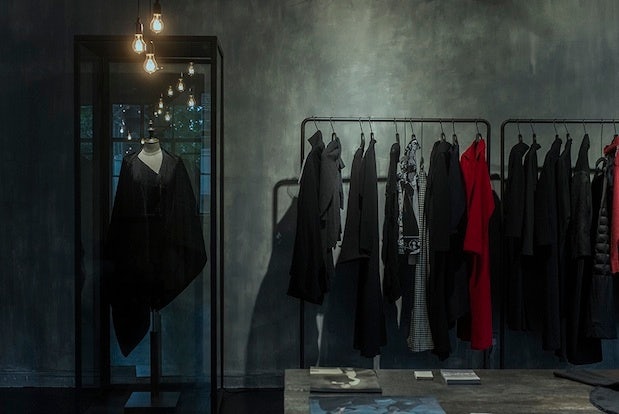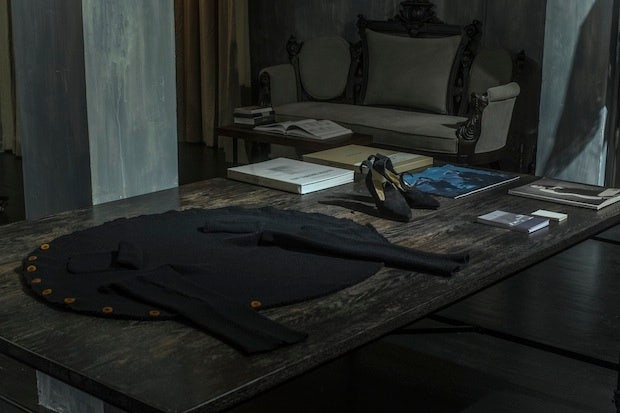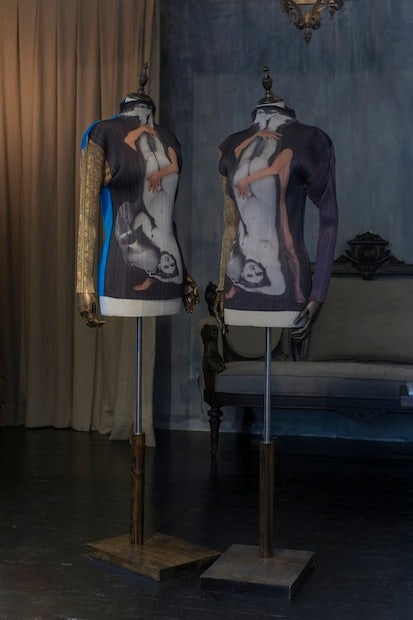
The interior of Old Lyric (Old Lyric)
I first heard of Old Lyric through a renowned Chinese fashion blogger’s Weibo. Founded a month ago, Old Lyric is already favored by professionals in the fashion industry. How did the boutique catch attention and receive good reviews in such a short period of time? With this question in mind, we visited Old Lyric, a space hidden in an old house on South Shanxi Road, Shanghai.
Strictly speaking, Old Lyric is a secondhand clothing boutique that carries 16 designer brands such as Ann Demeulemeester, Comme des Garçons, Dries Van Noten, Yohji Yamamoto, and Issey Miyake—indeed a gem for accessing top designers’ garments in China. The concept of a high-end secondhand boutique is nothing new in Western countries, but in China, Old Lyric is one of the first to introduce the idea of vintage luxury, serving as a window that introduces timeless classics to Shanghai, and maybe even to all of China.
In a 295-square-foot space, the interior design and the display of the boutique is serene and poetic, allowing each client to have a quiet and relaxed shopping experience. Jing Daily recently talked to Old Lyric's owner Zephy, who is good at photography, has extraordinary taste, and talks about business management with a passionate, prudent, and sharp outlook. Read below to hear her thoughts on running a vintage luxury store in China.
Where did the idea of opening this boutique come from?#
I had the idea of opening a boutique like this several years ago. We have been familiar with these designers, and we've seen their exhibitions in London. Despite the fact that they were small-scale exhibitions and no touching or photographs was allowed, they were quite popular. At the beginning, when I encountered designers' garments I liked, I would add them to my collection, and waited for the right timing to come. Instead of focusing on a niche market, we wanted to carry garments made by renowned designers during peak periods of their careers.
How did you come up with the name “Old Lyric”?#
We needed a theme to guide the visual impression of this boutique, and we chose “music”. Old Lyric's logo is a bass clef because we think the symbol looks chic. To echo the theme, the prints on our tags and shopping bags were obtained and redesigned from three composers' manuscripts. Meanwhile, the word “lyric” has the double meaning of “words of a song” and “poems that express personal feelings”, so the name “Old Lyric” conveys an idea of timelessness, serenity, and poetry, which are also the styles we look for when selecting collections for the store.

Could you describe Old Lyric’s clientele?#
We just started the business less than two months ago, so our clientele is still unstable at the moment. But overall, Old Lyric’s typical clients are professionals in the fashion and art industries, or fans of the fashion designers whose garments we carry.
On Old Lyric’s Weibo page, there are detailed descriptions of every piece you carry. Why did you decide to do that?#
My boyfriend and I worked on this together. We read a lot of books about these designers and fashion photography and art, so we have accumulated a certain amount of knowledge. We believe it is a good way to promote our business. To run a boutique like this, I want to demonstrate not only our precious collection to our clients, but also descriptions based on our expertise. You can probably see this information in a museum, but museums' collections are usually eye-catching styles, such as dramatic volume skirts. Videos and images from earlier days were rare. This is a way to let their earlier works and garments that are more practical and less dramatic be known. For example, Yohji Yamamoto is known for his black garments, but very few people know he has designed clothing in a variety of colors.
Educating the clients is indeed a good idea, and on the other hand, the information is a good supplement to mainstream fashion.#
Indeed. This information was rare, and we’ve been collecting for years. We will share more rare information from books in the near future. I usually scan the pages and then do the color correction and editing. We hope to share our unique views on the selection of books and clothes.

We know that Old Lyric’s website is still under development. Will you incorporate an online store to your website?#
We will not have an online store. We have our basic structure of the website created, but we are taking our time to complete it. Our store wants to provide our clients with a shopping experience in which they can try on and feel the clothes. Such experience is absent in online shopping. It is true that online shopping is now a trend, and I also purchase a wide range of things online, from furniture to spices. When I opened this boutique, I wanted to try to run a traditional retail store that is free from the impact of online shopping. Moreover, when these garments hit an online shopping platform, their value changes. People start to compare prices and therefore it soon becomes a malignant competition. It’s common to see online shoppers purchase on impulse, and I do not want our clients to buy our garments out of impulse.
How often does Old Lyric introduce new products?#
We basically introduce 10 new items every week; however, it sometimes depends on how fast they are sold. I don’t want the boutique to look too crowded, or it would affect the shopping experience. I want to have enough room to display the garments property, and let each piece be carefully looked at.
What is Old Lyric’s price range?#
We price our items based on how rare they are. Our prices typically range from 1,000 to 7,000 RMB. Those that are particularly rare, such as museum collection-level items we really like, are perhaps not for sale. If it is possible to obtain something similar to such types of items in the future, I will sell it for 8,000 RMB or more. Generally speaking, we don’t have items priced over 10,000 RMB. If they were priced too high, clients would be reluctant to come; if too low, it would be difficult for us to run the business.
What is your brand’s ratio between men’s and women’s clothes?#
Men’s clothes make up 30 percent, and women’s make up 70 percent. The designers' brands we select have high standards for the silhouette, so it is common to see masculine silhouettes tailored for women’s clothes. Many of our clients purchase both men’s and women’s clothes.

Besides Weibo, what are your other marketing platforms?#
We want to have offline marketing activities. We’ve thought about launching pop-up stores, but we haven’t come across a suitable collaborator whose positioning is similar, but with a different array of products. We will not do that unless we are fully prepared; we would rather wait until the time is right. We are still new to the scene, so we want to prove ourselves with business achievements, but not to convince people with bragging. We will do that when the business is stable enough.
Who are your favorite Chinese fashion designers?#
Uma Wang and Ziggy Chen. Their designs do not show a sense of chic, but timelessness and classic. I also like Shangguan Zhe (上官哲) because he is still young, can think outside of the box, and is full of potential. I believe he will become the next big name.
This article was originally published in Chinese. Translation by Jasmine Lu.